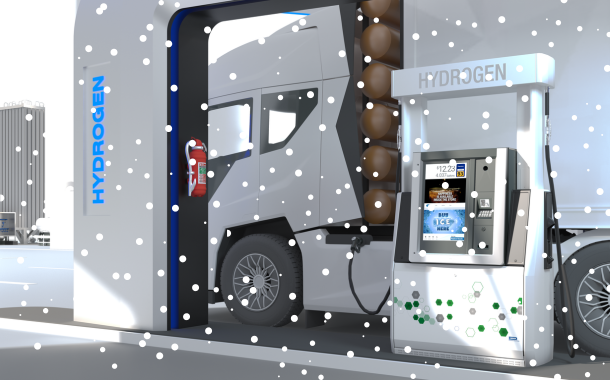Breaking the Ice: How Hydrogen Fuel Cell Vehicles Are Mastering Winter Operations
Published on January 13, 2025
As hydrogen fuel cell vehicles gain traction in the automotive industry, questions persist about their cold-weather capabilities. With winter temperatures plunging below freezing in many regions, understanding how these vehicles perform in harsh conditions is crucial for infrastructure planning and operational success.
Fuel Cell Winter Performance Analysis
Recent testing in extreme conditions has yielded promising results for hydrogen fuel cell vehicles. According to Cedric Herbreteau, Director, Clean Energy at Dover Fueling Solutions® (DFS), "The latest generation of fuel cell vehicles demonstrates remarkable resilience in sub-zero temperatures, with performance remaining stable down to -30°C. This represents a significant advancement in the technology's commercial viability."
Research funded under the National Fuel Cell Bus Program shows that when temperatures drop to between -5°C and 0°C, hydrogen buses experience a 23% decrease in range, again highlighting hydrogen’s suitability for cold weather conditions.
Maintaining Peak Performance in Winter
The maintenance requirements for fuel cell vehicles in winter are surprisingly straightforward. Unlike traditional combustion engines, fuel cells contain no moving parts and require minimal ongoing care. However, regular inspections remain crucial, particularly in cold conditions.
"The key to winter maintenance lies in preventive measures rather than reactive repairs," states Cedric Herbreteau. "Annual hydrogen tank and fuel cell stack inspections are essential, but the day-to-day maintenance is remarkably simple."
Regular maintenance consists of conducting annual fuel cell stack inspections and periodic hydrogen tank checks, alongside standard vehicle upkeep such as tyre rotations and brake services. Additionally, operators need to stay on top of routine tasks like cabin filter changes and windscreen fluid replenishment. These maintenance requirements are straightforward and predictable, allowing for efficient service scheduling.

Winter Driving Challenges
Cold weather operation presents unique challenges, particularly at temperatures below -20°C. At these extremes, fuel cell vehicles may face specific operational hurdles. The gas transfer module (GTM) becomes particularly sensitive to these conditions, potentially affecting fuelling operations.
"Temperature management is crucial for optimal performance," Cedric Herbreteau, explains "While fuel cells can operate effectively in cold conditions, maintaining fuel purity becomes more challenging at extreme temperatures. Proper infrastructure and handling protocols are essential."
Addressing Ice Formation Concerns
Concerns about water vapour emissions freezing in winter conditions have been thoroughly addressed by industry experts. Traditional petrol engines already produce water vapour emissions without causing significant problems, and fuel cell systems are designed to manage water vapour effectively.
The water vapour from fuel cell vehicles disperses into the air much like human breath on a cold day, rather than accumulating on road surfaces. The exhaust systems are designed and positioned to prevent any significant road surface impact."
Long-Term Prospects in Cold Climates
The outlook for fuel cell vehicles in cold climates appears promising. Market projections indicate substantial growth, with the sector expected to reach a value of US$207 billion by 2044. Fuel cells offer certain advantages in colder regions where battery efficiency typically diminishes.
"The hydrogen economy is set to transform cold-weather transportation," notes Cedric Herbreteau. ‘’While current challenges include infrastructure development and costs, the technology's superior cold-weather performance makes it particularly attractive for regions with harsh winters."
Key factors driving future adoption include enhanced energy density, faster refuelling times, better cold-weather performance, government incentives supporting adoption, and expanding hydrogen infrastructure.
Understanding these winter-specific aspects of hydrogen fuel cell vehicles is crucial for future planning. As the technology continues to evolve and improve, staying informed about cold-weather performance and maintenance requirements will be essential for successful implementation and operation of hydrogen fuelling infrastructure.
Long-Term Prospects in Cold Climates
The outlook for fuel cell vehicles in cold climates appears promising. Market projections indicate substantial growth, with the sector expected to reach a value of US$207 billion by 2044. Fuel cells offer certain advantages in colder regions where battery efficiency typically diminishes.
"The hydrogen economy is set to transform cold-weather transportation," notes Cedric Herbreteau. ‘’While current challenges include infrastructure development and costs, the technology's superior cold-weather performance makes it particularly attractive for regions with harsh winters."
Key factors driving future adoption include enhanced energy density, faster refuelling times, better cold-weather performance, government incentives supporting adoption, and expanding hydrogen infrastructure.
Understanding these winter-specific aspects of hydrogen fuel cell vehicles is crucial for future planning. As the technology continues to evolve and improve, staying informed about cold-weather performance and maintenance requirements will be essential for successful implementation and operation of hydrogen fuelling infrastructure.



